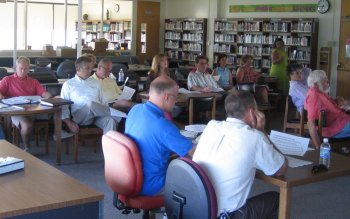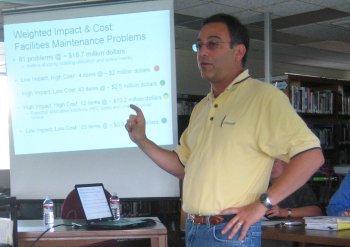- By Dan Veaner
- News
 Print
Print
Wednesday's school capital project Facilities Committee meeting seemed to put the process back on track when facilitator Marc Stammer took charge from the beginning. In stark contrast to last week's dysfunctional meeting, Stammer began with a thoughtful and detailed description of the process, a summary of what the group had accomplished and what his expectations for the evening were. Participants kept their emotions -- and barbed comments -- in check as they reviewed 14 problems in the physical plant that affect school programs.

Stammer owned the meeting, keeping the group on track and even pulling some results from the shambles of the previous meeting. He had, along with David Green of King & King Architects and Scott O'Neill of C&S Technical Resources, reworked the work sheets and, importantly, created a clear procedure for dissenting positions to be expressed. "We went through the process from last week and the comments we received, and tried to put some structure around them so we can address them," Stammer said.
Problems were presented with additional possible solutions pulled from the previous meeting, and were ordered by priority, and information was added to answer questions participants had raised. Unresolvable issues were put into a 'parking lot,' a list of things to revisit after the work of the evening was complete. That allowed the group to plow forward, and the 14 items were completed within a minute of the scheduled meeting's end.
Just about the only tangible accomplishment in the previous meeting was taking Middle School solutions that solve program problems off the table. Stammer explained why Superintendent Mark Lewis had requested taking them out of the mix. "It was there with respect to overcrowded classrooms for some of the programs," explained Stammer. "When the the design team looked at the building and tried to figure out how to optimize things all of the solutions would cause you to extend the building unless you moved the fifth grade to the Elementary School. Because one of the primary concerns of this group was to optimize facility utilization, that would be contrary to this hierarchy."

Group facilitator Marc Stammer
Stammer also sought to take emotion out of the decisions by quantifying the issues. He compiled a spreadsheet showing how many classrooms are needed using maximum and minimum enrollment projections. While he said that the calculation was a gross simplification, his figures confirmed that the High School is currently overcrowded. When Principal Michelle Stone explained some of the scheduling problems she faces, such as a mandate to put a much smaller number of special education students in a standard-size classroom or bigger, it was clear that the eight new general classrooms the group is contemplating was reasonable.
Stammer said that group will begin work on the 'portfolio' in its next meeting August 16. That means they will take the puzzle pieces, the solutions to the problems identified, and try to fit them into a coherent project scope, defining which solutions are in, and which are out. Some solutions may conflict or enhance each other. For example, building new classrooms may garner the most State aid, so replacing existing classrooms and then renovating that space for less aidable needs can make fiscal sense. However architect Kirk Narburgh noted that the State sets a maximum of about a dozen new classrooms that it will accept for aid in a project.
The problems included insufficient general classroom space, insufficient science program space, insufficient CADD technology space, inadequate special education and testing space, no existing computer lab, insufficient art space, no technology space in the High School, insufficient main office and nursing space and privacy, band and orchestra rooms too small, choral room inappropriately configured, no music lesson space, and no separate locker rooms for kids and the general public.
Not all will end up in the project. For instance the group was in agreement that the locker room is a dead issue. But they will attempt to put the puzzle together, deciding which items the district can afford and what size project taxpayers will accept.
Once the business of the meeting was over a general discussion ensued about the project in general. Tom LaVigne expressed a concern about who gets to vote. He took the position that only Lansing school taxpayers should have a vote. Lewis argued that teachers and administrators who are on the committee should have a vote. LaVigne, admitting that his purpose is to keep the taxes for the project as low as possible, said that non-taxpayers should not have a voice in what taxpayers ultimately pay. But the group agreed that those who have participated on the committee from the beginning, have attended most of the meetings and voiced opinions should get to vote. Music teacher Eric Hummel, an Ithaca resident, noted that there are only two teachers actually on the committee.
The original schedule called for the Facilities Group to present its recommendation the the Board of Education no later than the BOE's July reorganizational meeting, which took place July 10th. With slower than projected progress the group is meeting in two weeks, even though some had vacation plans and will not be able to attend. While the hope is to present it to the board in time for necessary processing by the Board and the State to allow a December vote, some doubt the group will be able to complete the recommendation in time. Still, they made some progress at the meeting Wednesday. Perhaps the most important progress was their agreement to go forward with the process.
----
v2i30

Stammer owned the meeting, keeping the group on track and even pulling some results from the shambles of the previous meeting. He had, along with David Green of King & King Architects and Scott O'Neill of C&S Technical Resources, reworked the work sheets and, importantly, created a clear procedure for dissenting positions to be expressed. "We went through the process from last week and the comments we received, and tried to put some structure around them so we can address them," Stammer said.
Problems were presented with additional possible solutions pulled from the previous meeting, and were ordered by priority, and information was added to answer questions participants had raised. Unresolvable issues were put into a 'parking lot,' a list of things to revisit after the work of the evening was complete. That allowed the group to plow forward, and the 14 items were completed within a minute of the scheduled meeting's end.
Just about the only tangible accomplishment in the previous meeting was taking Middle School solutions that solve program problems off the table. Stammer explained why Superintendent Mark Lewis had requested taking them out of the mix. "It was there with respect to overcrowded classrooms for some of the programs," explained Stammer. "When the the design team looked at the building and tried to figure out how to optimize things all of the solutions would cause you to extend the building unless you moved the fifth grade to the Elementary School. Because one of the primary concerns of this group was to optimize facility utilization, that would be contrary to this hierarchy."

Group facilitator Marc Stammer
Stammer also sought to take emotion out of the decisions by quantifying the issues. He compiled a spreadsheet showing how many classrooms are needed using maximum and minimum enrollment projections. While he said that the calculation was a gross simplification, his figures confirmed that the High School is currently overcrowded. When Principal Michelle Stone explained some of the scheduling problems she faces, such as a mandate to put a much smaller number of special education students in a standard-size classroom or bigger, it was clear that the eight new general classrooms the group is contemplating was reasonable.
Stammer said that group will begin work on the 'portfolio' in its next meeting August 16. That means they will take the puzzle pieces, the solutions to the problems identified, and try to fit them into a coherent project scope, defining which solutions are in, and which are out. Some solutions may conflict or enhance each other. For example, building new classrooms may garner the most State aid, so replacing existing classrooms and then renovating that space for less aidable needs can make fiscal sense. However architect Kirk Narburgh noted that the State sets a maximum of about a dozen new classrooms that it will accept for aid in a project.
The problems included insufficient general classroom space, insufficient science program space, insufficient CADD technology space, inadequate special education and testing space, no existing computer lab, insufficient art space, no technology space in the High School, insufficient main office and nursing space and privacy, band and orchestra rooms too small, choral room inappropriately configured, no music lesson space, and no separate locker rooms for kids and the general public.
Not all will end up in the project. For instance the group was in agreement that the locker room is a dead issue. But they will attempt to put the puzzle together, deciding which items the district can afford and what size project taxpayers will accept.
Once the business of the meeting was over a general discussion ensued about the project in general. Tom LaVigne expressed a concern about who gets to vote. He took the position that only Lansing school taxpayers should have a vote. Lewis argued that teachers and administrators who are on the committee should have a vote. LaVigne, admitting that his purpose is to keep the taxes for the project as low as possible, said that non-taxpayers should not have a voice in what taxpayers ultimately pay. But the group agreed that those who have participated on the committee from the beginning, have attended most of the meetings and voiced opinions should get to vote. Music teacher Eric Hummel, an Ithaca resident, noted that there are only two teachers actually on the committee.
The original schedule called for the Facilities Group to present its recommendation the the Board of Education no later than the BOE's July reorganizational meeting, which took place July 10th. With slower than projected progress the group is meeting in two weeks, even though some had vacation plans and will not be able to attend. While the hope is to present it to the board in time for necessary processing by the Board and the State to allow a December vote, some doubt the group will be able to complete the recommendation in time. Still, they made some progress at the meeting Wednesday. Perhaps the most important progress was their agreement to go forward with the process.
----
v2i30



